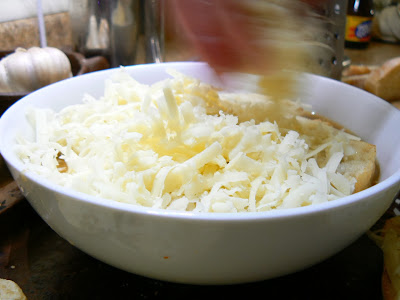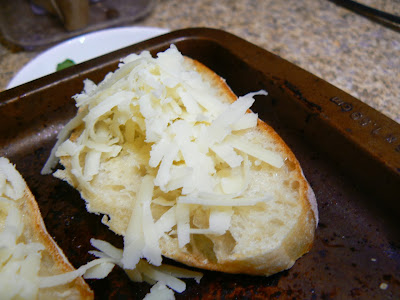French onion soup. Even typing the words makes my mouth water, though that may have something to do with the fact that I haven't eaten for about fourteen hours. Still, it's an amazing dish. I'd never had homemade French onion soup until Beth made it for me early on in our relationship. I'd only had it at restaurants, and most of that at Shallo's on the south side of Indianapolis. I'd swing by after work in the winter and enjoy a stout and a bowl of French onion soup before the kitchen closed. It was enjoyable for sure, but I'm of the opinion that in addition to the depth of flavor you get with homemade soup, nothing quite compares to your whole house smelling like caramelized onions for the rest of the day.
Beth learned how to make French onion soup by watching Julia Child, of course, as did a great number of folks in the United States. Her recipe is the standard by which all other versions of the dish are compared, and we use it as the starting point for our own version of the dish.
Here's what you'll need:
1 1/2 (about 5 cups) thinly-sliced yellow onions
3 Tbsp butter
1 Tbsp oil (we used olive oil)
1 tsp salt
1/4 tsp sugar (which helps the onions to brown)
3 Tbsp flour
2 qts boiling stock (traditionally beef, which works best, but you can substitute if need be)
1 tsp herbs (we used fresh and dried thyme, sage, and rosemary)
1/2 cup dry white wine
1/4 cup brandy or cognac
2 bay leaves
salt to taste
First off, you're gonna cut up your onions and cry a lot. Cut the onions in half from top to bottom and then slice them into thin half circles. This will make them long and thin in the final dish. Try to make them as uniform as possible so that they brown evenly.
Combine all your spices in a little bowl like this one. We're gonna dump them in early on, but you can add them whenever you like, really.
Put your butter and olive oil in a pot. A heavy-bottomed pot (like the dutch oven we used) is preferable because it distributes the heat evenly, which makes for uniform browning. In addition to this, heavy pots react to heat adjustments more subtly, which is better for controlling the temperature in the pot. Once it's all ready to go, dump in your onions and the spices. You want the heat on low to medium so that they don't brown up right away. Cook them in the butter and oil, covered, for about 15 minutes, until the onions are translucent and gooey. They'll look like this.
It takes a long time to caramelize onions (as opposed to burning them, which happens quickly). Once the onions are translucent, turn the heat up to medium. We're not even close to done yet, though, so maybe put on a podcast or some such biz to keep yourself occupied, as it's maybe not the most exciting part of making the soup. Stir in the salt and sugar, then stir the whole thing frequently until the onions are almost walnut-colored, about 30 to 50 minutes.
Start heating up your stock in another pot. Get it hot and let it simmer on low while the onions are cooking.
Speaking of the onions, here they are after a little while.
And later.
And later.
Now, around this point things get really real. They're gonna move from browning to burning if you're not careful. Stir them continually...
Now, around this point things get really real. They're gonna move from browning to burning if you're not careful. Stir them continually...
until...
...they reach this point.
Sprinkle in the flour and stir for 2 to 4 minutes. This will make the broth a little thicker once you pour it in. Cooking it now removes the flour-y flavor, so all that you're left with at the end is a thick, rich broth.
Turn the heat off. Totally. Pour in your stock.
Once the stock's in there, use a wooden spoon to dislodge the caramelized bits from the bottom of the pot; this deglazing will give a little more depth and body to the broth. Now add the brandy, wine and herbs, and mix it all up. Turn the heat back on and get the soup back to a low simmer. Let it simmer like this for 30 minutes to an hour. The longer you let it simmer, the more complex the flavor is going to be. Because there are really only two main flavors in this dish, the simmering is maybe more important than a soup with numerous flavors.
Now your soup is ready.
But the best is yet to come. Let's talk about bread for a moment, because it's important, and there's a few ways you can handle it. The greatest joy of French onion soup is to dig into the bread and cheese at the top, mingle it with the broth and onions and pop it into your mouth.
You can:
- Use smaller bowls, so that a single slice of a think baguette should be able to cover the entirety of the bowl's mouth.
- Use a larger bowl and buy a thicker bread that isn't a baguette so that it covers the entirety of the bowl's mouth.
- Use a larger bowl and put enough slices of a regular-sized baguette are required to cover the top of the soup.
Whichever way you choose to do it, it's important that the bread you choose is of the type that has a strong gluten network (like a baguette or ciabatta, where there are big pockets of air because the gluten is so strong that it keeps the air trapped when it bakes) and that it is a day or two old. Why? Because tough, stale bread is less likely to get disgustingly soggy while you melt the cheese, making it a great choice for the croute (which is what the bread on top is traditionally called). You don't want an Italian loaf or a farmhouse bread that's dense because it'll just soak up the broth and sink to the bottom of the bowl. We ended up making this on the spur of the moment, so we used a baguette that had been made that morning, which is just fine, obviously, since even fresh baguettes do alright in liquid. But under optimum conditions (that is to say, when we remember that we were gonna make French onion soup), we'd have bought the bread the day before and left it out to stale overnight.
Now, what kind of cheese should you use? Whatever you want, really, but you want something that's going to complement the onions and broth and not work against them. We're obligated to say that Swiss works well, specifically an aged Swiss, extra specifically Gruyere or Emmentaler. We used Gruyere. It can be a little pricey sometimes, but we'll buy it as a nice treat for ourselves when we're gonna make this dish because it works so well. It has a earthy, nutty flavor that complements the wine flavors in the broth and the sweetness of the onions.
Grate it up.
Ladle broth into the bowls, making sure to leave enough room for the bread and cheese. Put your bread on top of the broth and sprinkle the cheese over the bread. One of the advantages to using several pieces for the croute instead of just one big one is that some cheese will sink down to the bottom of the bowl, giving you a nice, cheesy surprise when you get to the bottom.
Put the bowls on a baking sheet and turn on your broiler. If you're smart you know that you'll be having more than one bowl, so just toast up some more bread slices to put in the unoccupied space of the baking sheet. Please excuse the condition of our baking sheet, but I have been known to fucking wreck a baking sheet if given half a chance. Need to create steam in an oven that probably should never have steam in it so that you can give a bread the proper crust? Just put a sacrificial baking sheet on the bottom of the oven and then put a cup of ice in it when you put the bread in. Does it work? Yes. Does it turn your baking sheet a dusty black that makes it look like you just unburied it from the backyard? Yes, yes it does.
But I digress.
Now listen, you don't have to use a broiler, but actually yes you do have to use a broiler. Sorry, I changed my mind mid-sentence. You can just put them in the oven at a very high temperature, I guess, and the cheese will get all melty and brown and bubbly and stuff, but you won't get the direct heat of the broiler, which is gonna be the quickest route to the desired result. If you don't have a broiler, well, that's a whole other kettle of fish. Do what you gotta do.
Put the baking sheet in the broiler. Be careful or you'll spill soup and bread and cheese all over the place (he says from experience).
Just let them cook for a few minutes, and take the pan out of the oven (CAREFULLY) once it's browned enough for your taste. Here it is:
Looks good, right? It is good.
It is so, so good.



















Okay so challenge time: I am deathly allergic to wine. Do you know of any acceptable substitutes? Because this looks amazing and I want it in my face ASAP.
ReplyDeleteYES! You can just use the cognac, it will still be delicious! A lot of recipes only call for wine or cognac, so just using the booze is totally fine! enjoy your noms!
DeleteI'm totally making this tomorrow and subbing vegetable stock for the beef and adding some worcestershire sauce. This will be great hermitting food. NOM.
ReplyDeleteLet us know how it goes! It's the best thing ever in the winter.
Delete